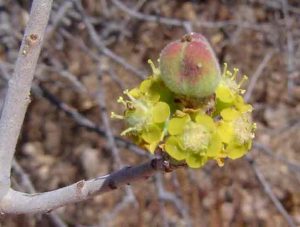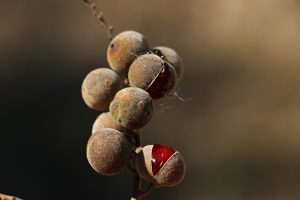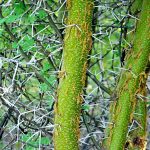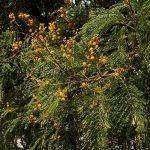TREE LIFE
MARCH 1990
YOU HAVE BEEN WARNED : (At our last Tree Society AGM) Tree Society subscriptions are increased to $15,00 this year. Your Committee has considered the increased costs in duplicating services, of paper, printing, postage and so on, and very much regrets that we have no option but to charge you more for your Tree Life – we still have the lowest rate of subscription of all the Societies operating in Zimbabwe. You may use the tear off slip on the reverse side of this page when making payment, either through the post to Box 23128 Harare, or to any Committee member. Subscriptions run from April to March and are thus due on 1st April. If you have already paid please ignore this request.
MASHONALAND CALENDAR
Tuesday 6th March: Botanic Garden Walk. Park your car at the Herbarium where we will meet at 1645 hours for 1700 hours.
Sunday 18th March: Mr. Stobart’s Atlanta Farm in the Arcturus area is the venue for our March outing. A well treed area near a dam is packed with interest. This is an own cars outing and we will meet on the farm at 1000 hours.
Saturday 24th March: Walk with Mark Hyde. Please phone Mark at home on 701023 before Friday 23rd for time and venue.
Monday 16th April to Friday 20th April: Do you fancy four nights and three days at the Victoria Falls? We have been lucky enough to reserve accommodation for 24 people. You will need to arrange your own transport to the Falls, bring your food, a towel, cutlery and crockery. The accommodation charge is $68 per person for the whole period. Please phone Maureen Silva Jones at work on Harare 739711 or write to Box 2128 Harare before 6th April to book. Anyone wishing to really indulge themselves may also like to stop off in Bulawayo, where I am sure our Bulawayo members would be very happy to show off their Matopos or Baikiaea plurijuga (teak) woodlands.
27th – 31st August: Any body wishing to attend the Forest Research Centre’s Research Seminar to be held in Mutare write to P.O. Box 2128 for information and pre-registration forms.
MATABELELAND CALENDAR
The same committee is continuing – namely Chairman Ken Blake, Secretary Charles Sykes, Treasurer Betty Blake, Member Geoff Archer.
Saturday 3rd March (please note): To Beaconsfield Farm of Derek and Barbara Viljoen. Meet at Grafotype Printers, 81 Mafeking Road (where cars can be left safely) An interesting and varied area. Barbara has offered to cater for lunch $4 per head (cold meats, salad and puds) good value, as I know from last time. Bring chairs, tea, cold drinks etc.
Sunday 1st April: To Quiet Waters Scheme of Falcon College, Esigodini. I know that last time we did not have any leaves, but they have grown since – and that is no April Food! All day outing. Bring lunch, and we can try out the new Tree Cards we have produced for this area. Meet at Ascot Car Park at 0830 hours.
Sunday 6th May: To Springs Farm (Richard Redman) about 30km from Bulawayo on the Maggie Wolhuter Road. A new area, morning only. Meet at Ascot Car Park at 0830 hours.
We are trying to arrange a long week end outing to Shashi River/Tuli on 25th/26/27 May, 1990. Conditions are still fairly primitive there, but not the trees. 264km from Bulawayo via Gwanda. Bear it in mind.!
MATABELELAND NOTES
RICHMOND NATURE PARK: The Bulawayo Municipality has set aside a beautiful 1000 acres stretching along the Victoria Falls Road about 10km out of the City. It has been fenced and at a meeting of environmental clubs and services organisations at the beginning of January it was explained that a number of animals are to be introduced which will help to form the Richmond Nature Park with conservation, education and recreational facilities. The Matabeleland Branch of the Tree Society is throwing its weight behind the scheme as there is a wealth of trees to be recorded and studied, and at our meeting on Sunday 4th February we did our first recce and during the morning’s outing we came up withy a total of 72 species. Entering from the gate it seems just to consist of Terminalia sericea, Dodonaea viscosa, Combretum apiculatum and Kirkia acuminata, but proceeding to the car park about 2km inside there is a foot path through Diploryhnchus condylocarpon (rubber tree), Grewia flavescens, G. monticola, G. bicolor, Albizia amara, Bridelia mollis, Maytenus heterophylla, M. senagalensis, Pappea capensis and Peltophorum africanum leading to a magnificent view point overlooking a river and trees as far as the eye can see, interspersed with enormous Aloe excelsa. This part becomes very rocky, in fact a miniature Matopas with such gems as Croton gratissimus, Erythrina latissima, Gardenia volkensii, Commiphora mollis, Burkea africana, Markhamia acuminate, Ozoroa insignis subs. reticulata, Pterocarpus rotundifolius, Rhus leptodictya, Vangueria infausta and Ximenia americana. Geoff Archer and Charles Sykes had worried frowns over two specimens, but eventually was resolved – Ochna puberula with beautiful “Mickey mouse” fruits and

Euphorbia matabelensis. Photo: Bart Wursten. Source: Flora of Zimbabwe.
Euphorbia matabelensis looking very fig like. Both these are quite rare for us, and Wendy Bullock solved another puzzle by identifying Cadaba termitaria another new one. After tea, interspersed with an AGM we proceeded to the far end, to the lower Umgusa Dam, large and spilling, to find a wealth of Acacias – A. nigrescens, A. karroo in full flower and scent, A. chariessa, A. arenaria and not to be out done with thorns, some enormous Ziziphus mucronata with the gaps filled in by Flueggea virosa and Dichrostachys cinerea. The Rhus pyroides, Bolusanthus speciosus and Combretum hereroense were doing well here but the acacias seem to be struggling under the weight of Viscum and Loranthus and is causing concern. A species in great profusion and size was the (to us) little known Ficus abutilifolia and the pink petioles brought a lot of comment. A wonderful morning in good weather and company, and after a few more outings in different parts of this area we will be producing a tree list for use by the public and school children when the park is officially opened in the middle of the year.
C. Sykes
A DAY IN THE NYARUPINDA CATCHMENT
Seldom have we had such a beautifully organised day, from the wide smile of the man on the road who had been put there specially to guide us from the turn off, to a cheery farewell from our host and hostess Maurice and Dickie Graves. What a pleasure it was to meet our Ayshire co-enthusiasts once again, an added bonus. I do not intend to catalogue everything that was seen and studied during the day – Dickie has given us such entertaining accounts in the past, with (we hope) more to come in the future. Sufficient to say that there was something for everyone. As the skies grew dark on the horizon and the oracles (the local farmers) were consulted and the consensus appeared to be that the storm would miss Tinto. As we slopped back to the homestead in driving rain the oracles formed a tight group and became engrossed in discussing matters agricultural. Dickie had made provision for the weather, however, and we finished the day taking part in a most entertaining quiz which she had prepared. 67 people thank you, Maurice and Dickie, for a truly splendid day at Tinto.
NYARUPINDA CATCHMENT
Knowledge of the many transitions from one soil type to another and back again is coming gradually, as the vegetation is observed in the catchment area. Perhaps an ecotone will be found – the edge where two plant communities overlap. There is no ecotone around the quartz rise at the house; the dry woodland-sandy soil tree species grow anywhere. They come right up the hill, e.g. Julbernardia globiflora and Brachystegia boehmii. Some have become wind pruned and others gnarled. Now doleritic clay and its parent rock dolerite will be considered. Dolerite has nothing to do with supermarkets. The word comes from the Greek language doleros which means deceptive. It was not easy to identify visually. In Zimbabwe soils are directly related to the rocks which lie beneath them. Dolerite rock is very heavy because it contains iron ore. Bantu iron workers used lumps of it to break up ore for smelting. Dolerite is used as road metal and there is a valuable dollar earner “Black granite” which is in demand in U.K. and Europe. Lorries from Mutoko with massive blocks of dolerite are seen on the outskirts of Harare. “Swedish Ebony” is actually dolerite. The foregoing shows that dolerite is actually Dollar Right for Zimbabwe. Dolerite weathers to faintly acid to mildly alkaline reddish brown heavy clay which offers a congenial environment for roots. The iron compounds engender a crumb structure in the upper layers, which is well serrated. At lower levels the clay becomes redder and heavier and heavier. This we have discovered when planting trees. In spite of this roots travel down to a great depth. Dolerite geology is worth looking at in any textbook on the subject. An ecotone may occur where the granite sands join the clay. Investigations are in progress.
Dickie Graves
NOTES FROM MUTARE
Some exciting news, an arboretum of sorts is being contemplated in Cecil Kop Reserve. On Tree Planting Day twenty Khaya nyasica were planted. This tree has virtually disappeared from the area on account of its good quality timber – it is easy to work and has a beautiful red polish. However, it has been noted that it has been making a comeback in some forest thickets which form the seen bank of the reserve. In fact it is interesting to note that four to five years ago, and even further back, a lot of areas, now forested were merely grassland. It appears there is a tendency towards re-aforestation prompted by protection within the reserve. This is supported by the apparent extension of the individual forest thickets. It is interesting to speculate on the influences that have occurred in the past, for example, population, climatic and edaphic factors. We were also given Afzelia quanzensis which has a reputation for growing in clearly delimited altitudes, not much above 3 000 feet. These trees were planted in a “low” area and in “dry” areas, as dry as one can get in the Mutare forest zone. It will be interesting to see how they do. If anyone has any ideas on planning an arboretum or would like to assist, please contact me.
MUKUVISI WOODLAND NOTES
Turning right from the Chiraura at the second dam site, we cross the old flood plain and begin to rise through mature musasa interspersed with large termite heaps. Pre 1982, apart from the diverse vegetation on the termitaria, this area was very degraded. Under storey, whether herb or shrub layer was largely absent. Mature Brachystegia predominated making a kind of interrupted climax. I can not account for this. I guess that long years of maltreatment by man, starting with goat pressure at the time of the last tribal occupation, followed by steady soil erosion due to general land mis-use, is the basic reason. It took three years behind the game fence before trampling and dunging caused formation of a satisfactory tilth, and now succession is under way again. I do not however expect much in the way or real results before the end of the century. The termitaria here are very interesting.

Pappea capensis. Photo: Mark Hyde. Source: Flora of Zimbabwe
Bushbuck browse stimulates growth more than it causes damage. Comparison of the termite heaps inside the fence, with those outside will be very interesting in a few years time. Topping the rise we come to the quarries. Probably started as prospecting trenches, later explicated for stone and gravel, they ended up as municipal refuse tips. The refuse was cleared away in 1973 and the pits and surrounding areas have been recovering since then. Collectively they comprise an interesting experiment in succession from bare soil/rock. It distresses me to hear the perpetual ‘parrot cry’ “reclaim the quarries”. Apart from a little controlled experimentation the area must be left to plant succession, a careful study over the years is rewarding, and the area makes for being an open air teaching aid to scholars and teachers. One of the interesting plants along the ridge here is Uapaca kirkiana, numbers have increased greatly since 1981, fire control is, I think, the basic reason. Amongst the quarries we have the sole specimen known to me, of Acacia longifolia. In early days of conservation I had to protect this plant from my friends who wished to destroy it because it was an exotic. I wanted to study it and see its place in succession. Also nearby is one Acacia erubescens, it is self sown, I do not know how or why. A. sieberana is important in this pioneer environment. We have several individuals whose life is being monitored, results are interesting. Near here we are likely to meet Skippy alias Friendly and semi tame duiker, one of her favourite places in the outlying termitaria with the only really mature Pappea capensis I know of in the Woodland. There is so much of interest. More next month.
FOOTNOTE On our visit to Tinto some members saw the damage caused by the parasitic plant, Pilostyles aethiopica Welw (family RAFFLESIACEAE). The following information comes from a back number of Tree Life, but will still be of interest. This plant grows on twigs and branches of Brachystegia and Julbernardia species and probably occurs throughout much of the Central African area where these species are found. The plant feeds on the twigs and branches of these trees, eventually killing the most affected parts of the tree. The plant flowers during the rainy season. Flowers are pinkish or flesh coloured, the petal being pinkish red with paler margins, rather fleshy in texture, and are visited by flies, ants, and other insects. The small cup shaped perianth remains on the twig or branch and badly affected branches have a barnacle encrusted appearance.
A CANOE TRIP – OR WILL THEY STILL BE TALKING TO EACH OTHER WHEN THEY GET BACK???
The whole idea seems a bit preposterous when you think about it. 6 middle aged couples on a canoe trip down the Zambezi River roughing it at night sleeping on the ground underneath the stars facing hippos, crocs, swirls and eddies and Heaven knows what else for three nights and two and a half days.
When did it all start and why? It all seems to have begun sitting round drinks one evening at the Cutty Sark in Kariba at the Cattle Producers Association annual congress in 1988. At the time I do not think anyone thought seriously that it was anything other than idle chatter except Ben and Jenny Norton who have a way of making things happen.
And so they begin organizing the trip and persuading all the busy farmers cum company directors cum board chairmen to keep a week free in their diaries so we could embark on this ambitious escapade. We were sent brochures and given the dates and so it all started to happen. The brochures made the whole thing look remarkably attractive but there was one feature they all had in common. Not one of the pictures showed anyone who could possibly be over the age of 25. that did not deter us however and so eventually we arrived at Chirundu on Monday 3rd April for our individually tailored canoe safari. The original idea had been a leisurely trip to Rukomechi from Chirundu taking two and a half days but National Parks have specified sleeping areas and there were not enough of those between these two points to allow such a plan so at the last minute we were told that we would be going to Mana another day beyond Rukomechi, giving a total canoeing distance of about 70km and then brought back to Rukomechi by boat where we were to spend two days in the luxury of the Rukomechi Safari Camp. The members of the party were Ben and Jenny Norton, Dave and Margy Tredgold, Bob and Vicky Rutherford, Mick and Cathy Townsend, Charlotte and Keith Kirkman and Jim and Ann Sinclair. Ages ranged from 43 to 60. This was the motley crew that found themselves on the banks of the Zambezi underneath the Chirundu Bridge at midday looking with some apprehension at the 8 two man canoes lines up on the bank. Each canoe was 5.7 metres long made of fibreglass with a seat at the front and back and in the middle was a box containing the food and hardware such as folding tables, stools and so on. We packed our kit in around this and once again felt smug about our success in travelling light, a result of many years experience and not the case with all the party!! We met our guides Titch Atkinson and Anthony Elton. Titch is not a full time guide being the manager of Rukomechi Camp but was filling in because there was a shortage of full time guides. They have to pass several exams before they are allowed to take parties on the river. We were divided into two parties and we had Titch as our guide and most satisfactory was his knowledge was first class and he was happy to impart it and Ann was able to spend much time on her tree interest with him. Although some members of the party felt they did not want to travel with their spouses we were happy to do so and were glad that was the way it turned out. The first impression of course was the sheer size of the river and the volume flowing down it. The Zambezi is of course the heart of one of the world’s great river systems and we were familiar with it from our previous trips with Ben and Jenny in Ben’s speed boat. But this was very different and here we were in these insignificant canoes paddling along learning how to steer and keep up with the guide and marvelling at it all. The trick is to remember that 70% of the steering effect is in the hands of the rear paddler so to speak and we soon learnt that it is not a matter of merely drifting but that you really do have to work quite hard. The front man is also important from an effort point of view and the whole effect seems designed to test a partnership to the hilt. I have to say that Ann and I got on just fine and exchanged no harsh words and soon got the hang of it all. I had been very worried that the effort of paddling might be very hard on the shoulders but I need not have worried and we soon set into a rhythm which gave us time and the opportunity to start observing the scene around about us. You certainly get a different perspective on life when you are seated a couple of inches from the surface of a mighty river such as the Zambezi. We paddled out into the river and past the ruins of the Chirundu Sugar Estate and through flat and rather featureless terrain before getting into more wooded and interesting country a little further downstream. – to be continued…
Jim and Ann Sinclair
DICK HICKS CHAIRMAN



